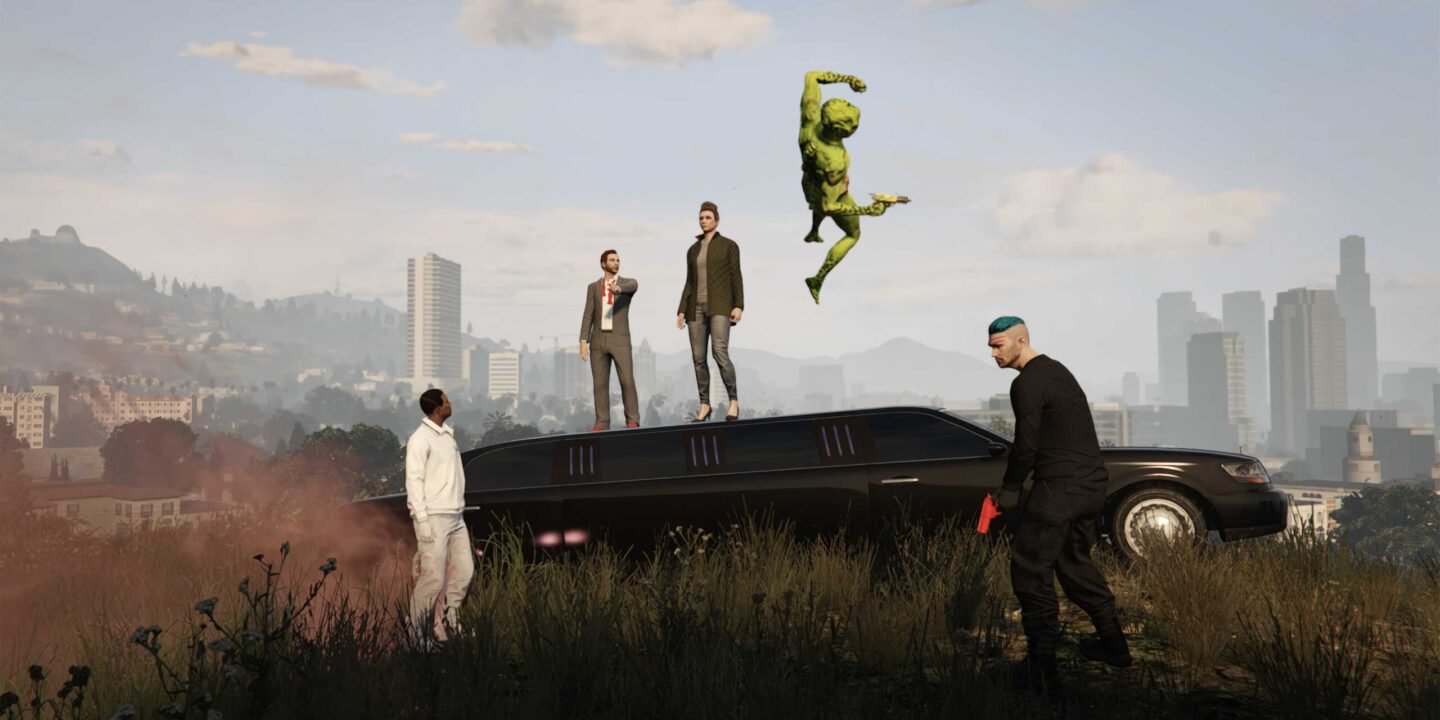
I watch a lot of movies, but I’ve never seen anything quite like Grand Theft Hamlet.
It’s a documentary film about the efforts of English actors Sam Crane and Mark Oosterveen to stage a production of Hamlet in none other than Grand Theft Auto Online. That alone is a wild concept, and what makes it even more impressive is the fact that it was entirely shot within the massively popular Rockstar game. All told, it’s a dramatic evolution of the kinds of ‘machinima’ media we saw in the early internet age, most famously with Rooster Teeth’s Halo spoof Red vs. Blue.
In Grand Theft Hamlet, directors and real-life partners Crane (Harry Potter and the Cursed Child) and Pinny Grylls (Hear My Voice) chronicle the challenges of organizing such a production, especially in an online game where anyone can kill you, leading to a great deal of chaotic humour. At the same time, the film is a surprisingly touching tribute to the timelessness of art, the creative process and how digital media can bring the world together. It’s one of my favourite films of the year so far, and I’m eager for more people to watch it.
To learn more about the making of Grand Theft Hamlet, I had the pleasure of speaking with Crane and Grylls. During our chat, we talked about the overlap between theatre and games, some of the lovely anecdotes of random people they met in GTA Online and misconceptions surrounding violent video games.
In recent years, we’ve seen more video games from people with theatre backgrounds, and now we have your film. From your perspective, what is it that games and theatre have in common?
Penny Grylls: I think it’s just the excitement of doing something live. You know that you’re responding in the moment to something in front of you that is live. It’s alive. When you go inside a game, especially an online game in particular, you know there are other people there. You know you’re having to make quick decisions — you’re having to, in some ways, perform. You know you’re an avatar, essentially. You are like a performer, a player, right? And that’s also the name for an actor, if you like, on stage: a player. So I think there’s a natural [connection].
Sam Crane: You think about plays and playing and games, it’s a similar kind of whole idea, at its basic concept. When you play a game, you’re getting to free yourself from the constraints of everyday reality. And there’s a similar thing that goes on when you perform in a play, or even sometimes when you watch a play — you go into a created world, and you have that wonderful freedom from reality.
The film shows in great detail — often to very amusing results — just how chaotic it can be filming in something like GTA Online. But I’m curious, beyond that chaos, about the moment-to-moment filmmaking process. GTA Online does have some perspective change options, but for the most part, you’re confined to what’s in the world already. What were some of the challenges in staging these productions and then also trying to get the shots for the documentary angle of it within the confines of GTA Online?

Grylls: [to Crane] You can talk about the staging first of the theatre performance, because there was actually quite a lot of creativity.
Crane: Yeah, I guess we wanted to really use all the kind of wonderful aspects of the game there are. So that’s why, quite early on — although there was something quite appealing about the the Vinewood Bowl as a very traditionally conceptualized stage space — we thought there’s so many incredible locations in this game. We wanted to use them and find ways to transport all the actors and the audience around the place to the different locations. That was really fun, actually.
Grylls: And there are things like when, say, the scene where Hamlet accidentally murders Polonius. That’s supposed to be inside a closet, and you realize you couldn’t kill people inside.
Crane: [laughs] Yeah, in interior spaces, you can’t get weapons out. And Hamlet’s got to be able to kill Polonius. So then we found this really cool space, the grotto by the playboy mansion, which had a great atmosphere actually, and visually looked really cool as well. And you can get a weapon out.

Grylls: And so sometimes the restrictions are actually the source of the creativity of what you’re doing. And I think that’s the same with filmmaking. When you’re thinking, ‘Well, okay, I have a limited number of options,’ what I was trying to do was introduce a bit of life, but also a bit of space around the action. On YouTube, you see a lot of gaming footage, which is very hectic and doesn’t feel very intimate. It doesn’t feel like it’s sort of revealing some textual things about the characters or anything like that. So I tried to use the in-game camera to create close-ups to get that sort of intimacy with the avatars, but also just to keep things quite still and to allow in the edit some space around moments, which I don’t think many YouTube videos probably have. But really, the game is this really cinematic space. It’s got this beautiful light — the light changes very fast, but it nevertheless is very beautiful. The architecture, the landscapes, the NPCs within the game are so beautifully designed. They’re really well scripted. It’s a satirical take on America, and it’s a very interesting space to work in as a filmmaker.
One of the hallmarks of an online sandbox game like GTA, of course, is the spontaneity that comes about with all the different people coming in and out. The film shows some of the many people that came through — DJ Phil and ParTeb the alien were especially funny inclusions. Of course, you would expect people to come in and shoot you and mess up the filming. But are there any anecdotes — people that either made it into the film or were left on the cutting floor — that stood out to you in terms of enhancing the sort of themes of the film that you were going for?
Grylls: Actually, very late on in the edit, the guy who we met who’s an Uber driver who broke his leg. He wasn’t actually included in the edit for a very long time. And I was editing the sequence, which was about you trying to make sense of ‘To be or not to be,’ and the ‘slings and arrows of outrageous fortune.’ This idea of, the things that everybody who’s alive have to go through; things suddenly happen to you. You break your leg, somebody in your family dies, something happens, and you have to find a way of carrying on, actually — probably because you’re a coward, because you don’t really know what’s next. There’s that speech. It’s so famous because of that — because it’s universal. And I guess that I put that scene in really last minute, because I felt we met a lot of different people in the game, but a lot of them did end up on the cutting room. But he particularly just seemed to be someone [interesting].
Crane: I just remembered there’s one really funny thing that didn’t make it in. In one of the very early rehearsals, there was someone who turned up and was hanging around, and the avatar was in the space with us, but someone else in the session was pretending to be that avatar.
Grylls: Oh yeah!
Crane: And they were speaking as if they were them. And then we got really confused. And then that actual avatar was being voiced by someone with a computerized voice.
Grylls: In Google Translate!
Crane: In Google Translate. And then we were like, ‘Who is the real version of this avatar?’ And then there was like a fake version called ‘Hacklin.’ And we were like, ‘Who is the real Hacklin?’ That was really interesting and fun.

Grylls: I needed to cut down that scene completely, but it was originally a scene about people literally pretending to be something they’re not, which happens all the time in the game. But just to go back to the Uber driver thing… [to Crane] Do you remember when Mark did a Spanish version of ‘to be or not to be’ for this guy so that he could understand it? And the guy was like, ‘I’ve never had anyone do it in Spanish for me before.’
Crane: Yeah, there were lots of really nice moments like that, but we couldn’t quite find the space for it in the finished film.
Grylls: Yeah, that didn’t make the cut.
That’s a great anecdote.
Crane: Really great exclusive reveal there — we haven’t mentioned that to anyone before.
Oh, thank you so much! [laughs] I mainly cover games, which is why I was so intrigued by this film. And I’m often frustrated by this sort of outdated view of gaming in the mainstream [and blaming it for social issues like gun violence]. Something I really love about your film is you don’t shy away from the fact that, yes, GTA Online is a very violent game, but also, there’s so much more to it than that, and you all came to a deeper understanding and appreciation of it. So I’m curious — for other people who are going to come into this film with more outdated views of games or are just not really aware of games and digital media in general, what would you hope that they would maybe take away from Grand Theft Hamlet and how it might change their perceptions?
Grylls: I hope they come to appreciate the same games in the same way we do for being highly sophisticated forms of storytelling that are also a growth area. Seeing what games do in the future is going to be incredible — we need to be engaging in these spaces. It’s so odd that cinema audiences and gaming audiences seem quite separate. Obviously, there’s a crossover, but it’s amazing, isn’t it, that [divide].

Crane: I also think that if you’re going to have a problem with violence in video games, you should really have a problem with violence in classic theatre, like in Hamlet.
Grylls: Or in films!
Crane: Or in films, yeah. But even more so [in theatre] — because people often say, ‘Oh, in theatre, this is a high art form, so it’s fine that there’s all this hideous violence.’ But it’s still just representations of violence in culture. And, why specifically, have a problem with it in video games, if you don’t in theatre? You’ve got to see them as equivalent media, I think.
Grylls: I think it’s because people think that games are being literal, and I don’t think they realize that something like Grand Theft Auto is a satirical take on America and it’s not to be taken literally. Which I think is why it’s important that only kids over a certain age play it, because then they have the sophistication to understand that.
This interview has been edited for language and clarity.
Grand Theft Hamlet is now streaming exclusively on Mubi in Canada. A $16.99/month Mubi subscription is required following a free seven-day trial.
Image credit: Mubi
MobileSyrup may earn a commission from purchases made via our links, which helps fund the journalism we provide free on our website. These links do not influence our editorial content. Support us here.











